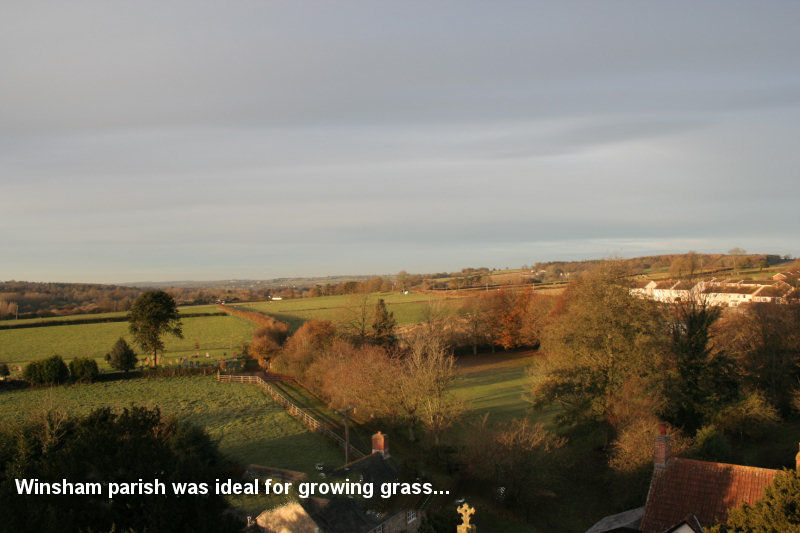| Agriculture
The Golden Age 1950-1980
|
The Golden Age
It is justifiably asserted that science won the second World War -
especially the development of Electronics. Radar revolutionised
observation and strategy, and the Atomic Bomb abruptly finished the job.
With the peace that followed the end of World War II (1945) , science
quickly turned it's attention to Farming. The Government Agricultural
Development and Advisory Service replaced the old War Agricultural
Committees.
A farming revolution
The farm supply companies - from machinery to
chemicals - soon bombarded the farmers with new
ideas and the ways of increasing production. Farmers were then the 'blue
eyed boys'. In the process, farming lost much of the its magic, and many
an old head was shaken in lament.
Winsham parish was ideally suited to growing grass, and the advent of
silage to replace most of the hay, and the use of the buck-rake and later
the forage harvester, speeded the whole
process of conservation. New varieties of rapid growing rye grass
replaced the mixed swards of old,
and the spinning fertilizer distributor meant three heavy cuts a year
and a period of grazing from every treated acre.

A certain amount of fine weather hay was field baled for collection.
To eat this was the 100 cow dairy herd ,equipped with the
'herringbone'-milking parlour, pit silage and cubicle housing . Ideally,
this included the large Friesian or Holstein, specialist milking breeds,
together with, perhaps, a few Ayrshires to improve quality (butter fat).
All were housed in giant metal wide span buildings. Artificial
Insemination (A.I.)- in our case from Horlick's Cattle Breeding Centre at
IIminster - meant the highest quality pedigree bulls were used for pure
breeding or cross-bred beef. The Charolais bull largely replaced the old
Hereford, Devon or Aberdeen Angus for beef crossing.
For poultry, the Battery House replaced, with cages in tiers, the old
poultry flock found around the Farm yard . One bird per cage (later two).
The hens were bought as day-old chicks (sexed) from a specialist breeder.
The breed was modelled on the old white Leghorn. With the eggs laid on
sloping wire floors, broodiness was no longer a problem.
Pigs were bred from sows living in arks on grassland, and were brought
into gridded pens for farrowing.The boar would be now a Landrace for bacon
production.
There was a revolution in machinery. Tractor rear lift arms took the
wheels off the ploughs and the
mowers. Ever larger tractors, forage harvesters, the fore loaders did
the 'lumping'. The six-ton tipping trailer hauled the grass. Hedge
slashers replaced the cutter. |
Somerset Farming Millionaires?!
Government subsidies were paid on quantity. The
large machinery required large fields. A bulldozer with grab could level
one hundred yards of hedge in an hour. Winsham had its own Agricultural
Contractor ... at Whatley. Another Winsham farmer had joined a silage
machinery syndicate run by The Cricket Estate who had four large dairy
herds to feed. There were soon rumours of Somerset farm millionaires!
Maize - as silage - replaced green and root crops for cattle feed. New
chemicals as pesticides, herbicides or medicines continually appeared as
did purpose mixed fertilizers in larger packs. The A.D.A.S. arranged
lectures and demonstrations for farmers. The BBC 'Farming Today' (Jimmy
Thorburn and Ralph Whitman) with farming guests (occasionally from
Winsham) appeared twice a week in prime time Radio. There were even
farming coach trips abroad. The cry was for gross output, specialization,
expansion, and guaranteed prices! Subsidies from U.K. Governments, and
later from the E.E.C made the farmer's life a happy one. As expected
farming output rocketed, but by 1980 surpluses began to build the
legendary surplus 'mountains' of Milk, Meat and Grain. Wine (on the
Continent) even had its own 'lake'. The bubble had to burst! Farming had
to return to earth!
Return to Browse index
Return to Site
Map
|
|
Copyright ©
Winsham Web Museum. All rights reserved.
This page revised
25 January 2016
|